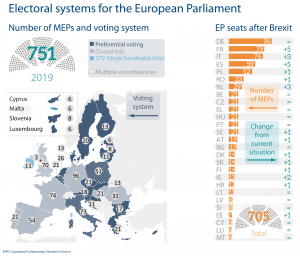The EP currently has 751 seats, as in the 2014-19 term, the maximum possible under the EU Treaties. Assuming the United Kingdom leaves the EU, the number of seats will fall to 705. Of the 73 seats vacated by Members elected in the UK, 27 will be redistributed among 14 Member States. Those 14 countries were to make provision at the 2019 elections for filling those seats once Brexit takes place. The remaining 46 seats would be available for potential EU enlargements and/or for the possible creation of a transnational constituency in future European elections.
MEPs are elected under national electoral systems, but these have to observe certain common principles established in EU law, notably proportional representation. As a general rule, voters can choose between political parties, individual candidates or both. Whilst in some Member States, voters can only vote for a list, with no possibility of changing the order of candidates (closed list), in others, voters can express their preference for one or more of the candidates (preferential voting). Instead of a list system, some Member States offer preferential voting by using the single transferable vote (STV).








Be the first to write a comment.